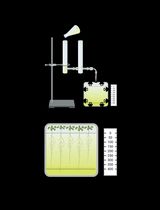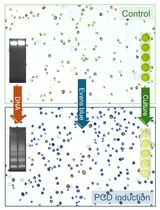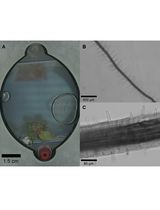- EN - English
- CN - 中文
Pneumatic Method to Measure Plant Xylem Embolism
气动法检测植物木质部栓塞
(*contributed equally to this work) 发布: 2018年10月20日第8卷第20期 DOI: 10.21769/BioProtoc.3059 浏览次数: 7278
评审: Amey RedkarChristine ScoffoniDheeraj Singh Rathore

相关实验方案

利用体外渗透梯度实验系统评估拟南芥主根对渗透胁迫的响应生长
Selene Píriz-Pezzutto [...] Mariana Sotelo-Silveira
2025年07月20日 1836 阅读
Abstract
Embolism, the formation of air bubbles in the plant water transport system, has a major impact on plant water relations. Embolism formation in the water transport system of plants disrupts plant water transport capacity, impairing plant functioning and triggering plant mortality. Measuring embolism with traditional hydraulic methods is both time-consuming and requires large amounts of plant material. While the stem hydraulic methods measure loss of xylem hydraulic conductance due to embolism formation, the pneumatic method directly quantifies the amount of emboli inside the xylem as changes in xylem air content. The pneumatic method is an easy and fast (8+ embolism curves per day) method to measure plant embolism requiring minimal plant material. Here, we provide detailed descriptions and recent technical improvements on the pneumatic method.
Keywords: Embolism resistance (抗栓性)Background
Plant xylem embolizes due to the entry of air into the xylem vessels under drought conditions. Resistance to embolism formation is one of the most important plant traits strongly determining species distribution, mortality and evolution (Choat et al., 2012; Rowland et al., 2015; Larter et al., 2017) and has been recently suggested as a key trait to model plant function and predict plant responses to global changes (Sperry and Love, 2015; Brodribb, 2017). Most methods used to estimate embolism resistance measures the hydraulic conductivity of embolized branch segments and relate it to the hydraulic conductance of the branch segment without embolism (Sperry et al., 1988; Melcher et al., 2012). These methods are usually time-consuming and prone to several artifacts (Wheeler et al., 2013; Trifilò et al., 2014; Beikircher and Mayr, 2016).
The pneumatic method has been recently proposed as an alternative method to estimate embolism resistance from a different point of view, not from the water flow perspective but from the direct consequence of embolism-air presence in the xylem (Pereira et al., 2016). As plant embolizes, air spaces inside the xylem increase. Embolism thus changes the pneumatic properties of branch segments. In this method, a vacuum is applied to a cut branch and the air flowing outside the branch is measured as an estimate of xylem air content. A strong relationship exists between air flow outside the branch segment and the amount of emboli in the branch xylem (Pereira et al., 2016; Zhang et al., 2018). The vacuum method presents a simple, low cost, fast and practical method to measure plant embolism. Additionally, the pneumatic method does not require rehydrating (flushing water) through samples in which the effects of drought are being studied.
Materials and Reagents
- Pneumatic apparatus
- Adapter Luers (Cole-Parmer, catalog numbers: EW-30800-06 and EW-30800-24)
- 1 L Kitasato flask (Prolab, catalog number: PL287)
- Silicone tubing (3 mm ID and 5.2 mm OD and 4.9 mm ID and 9.7 mm OD, larger or smaller sizes depending on sample diameter, with preferences for thick walled tubes, as they seal better after clamping)
- Rigid tubing (Cole-Parmer, catalog number: EW-30600-62)
- Vacuum source, either a syringe or vacuum pump (Prolab, catalog numbers: 032357 and VAC29-110, respectively)
- Three-way stopcock (Cole-Parmer, catalog number: EW-30600-07)
- Vacuum reservoir (a container or tube with rigid walls to store vacuum; 1-10 ml volume is usually enough)
- Vacuum meter, 30 to 110 kPa recommended (Honeywell, catalog numbers: 142PC05D or 26PCCFA6D or MPX5100AP; NXP Semiconductors; Netherlands. Farnell, catalog numbers: 1386589, 731766 and 1457156, respectively)
- Sample preparation and handling
- Plastic glue
- Plastic paraffin film (Prolab, catalog number: PM996)
- Plastic clamps (Cole-Parmer, catalog number: RZ-06832-02) and/or zip ties
Equipment
- Voltage meter
- Pliers
- Sharp razors
- Voltmeter or voltage logger (1 mV precision for 142PC05D or MPX5100AP, 0.01 mV precision for 26PCCFA6D)
- Alternative: Pneumatic Shield for Arduino UNO microcontroller board (Plant Technology and Environmental Monitoring–PLANTEM), to use with 26PCCFA6D (see details in the Figure 4)
- Xylem water potential measurement
- Pressure chamber (PMS Instruments, model: PMS 1000, or other)
- Notebook and USB digital microscope (Jiusion, or other)
Note: We discourage the use of magnifying glasses because of safety issues.
Procedure
文章信息
版权信息
© 2018 The Authors; exclusive licensee Bio-protocol LLC.
如何引用
Bittencourt, P. R. L., Pereira, L. and Oliveira, R. S. (2018). Pneumatic Method to Measure Plant Xylem Embolism. Bio-protocol 8(20): e3059. DOI: 10.21769/BioProtoc.3059.
分类
植物科学 > 植物生理学 > 非生物胁迫
植物科学 > 植物生理学 > 水转运
您对这篇实验方法有问题吗?
在此处发布您的问题,我们将邀请本文作者来回答。同时,我们会将您的问题发布到Bio-protocol Exchange,以便寻求社区成员的帮助。
Share
Bluesky
X
Copy link











